Carl E. Olson's Blog, page 137
August 14, 2013
Why Reza Aslan's Jesus is dull, confusing, and lacking
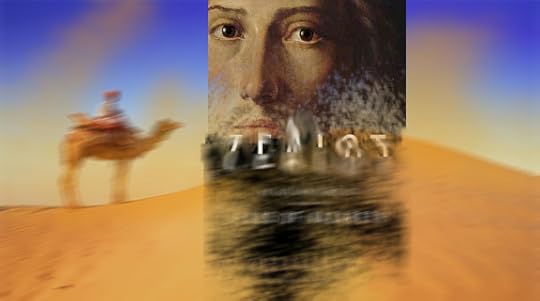
Why Reza Aslan's Jesus is dull, confusing, and lacking
| Carl E. Olson | CWR blog
The author of Zealot has more in common with Dan Brown and Deepak Chopra than with actual Scripture scholars
"And so each subsequent epoch in theology found its own ideas in Jesus,
and could find no other way of bringing him to life. Not only epochs
found themselves in him. Each individual recreated him in the image of
his own personality." — Albert Schweitzer, The Quest of the Historical Jesus (1906)
I am not a Scripture scholar, nor do I play one on television. But the study of Scripture and the specific study of Christology has been of great interest to me since I was a young man. My personal library has an entire bookcase of works of Christology, ranging from left to right, high to low, liberal to conservative. If there is one thing I have learned in reading many different books on the life and teachings of Jesus Christ, it is this: there is nothing—absolutely nothing—new under the sun when it comes to grand theories and elaborate meta-narratives attempting to explain (or explain away) the man from Nazareth. Anyone who follows the field, even as a curious amateur, knows this to be the case.
But—and it's an important "but"—99.9% of people don't know this. And a number of those folks are curious about, or even obsessed by, seemingly original explanations about the "truth" regarding Jesus. (Mark Shea, in his recent CWR article, "The Messiah We Need, Not the Messiah We Want", delves into this very nicely.) For my part, I've tackled this in detail on two specific fronts. The first was The Da Vinci Code, which was constructed (like a deck of cards in a hurricane) on the premise that Jesus was a mere mortal whose sole claim to any sort of uniqueness was due to his alleged marriage to the "goddess" Mary Magdalene. The entire third chapter of The Da Vinci Hoax, which I co-authored with medievalist Sandra Miesel, was on "The Christ and the Code." There, we showed how Brown based nearly all of his "research" on conspiracy-theory-laden books including Holy Blood, Holy Grail and The Templar Revelation. The second was The Third Jesus, authored by New Age guru and peddler of neo-gnostic syncretism, Deepak Chopra, a book that was so laughably ignorant and brazenly arrogant that I likely took a bit too much pleasure in shredding it in this lengthy 2008 review.
What I've found in reading Brown, Chopra, and similar authors, are two consistent qualities: a nearly neurotic conviction that they have—at last!—discovered the untold, hidden, and shocking "truth" about Jesus, and an equally unshakeable conviction that anyone who disagrees with them is either a fearful Fundamentalist or a brain-washed papist. What they miss, among many other things, is something put very well by the noted New Testament scholar, Dr. Craig A. Evans in his book, Fabricating Jesus: How Modern Scholars Distort the Gospels (IVP, 2006): "Radical skepticism is no more critical than is credulity."
Which brings me to Reza Aslan's best-selling, attention-grabbing, and radically skeptical book, Zealot: The Life and Times of Jesus of Nazareth (Random House, 2013), which has stirred up controversy (however contrived it might be) and sent many media types into fits of ecstasy. The book, The New Yorker authoritatively informs readers, is "an original account" (no, it's not; more on that in a moment), while the San Francisco Chronicle states, "Aslan’s insistence on human and historical actuality turns out to be far more interesting than dogmatic theology." Ah. Because we all know that dogma has nothing to do with human and historical actuality—especially if we don't bother to study the history of Christian theology, the early councils, and the subsequent debates within just the Church.
Apologist Jimmy Akin has penned a helpful primer and overview of Zealot and the surrounding hoopla.
The Messiah We Need, Not the Messiah We Want
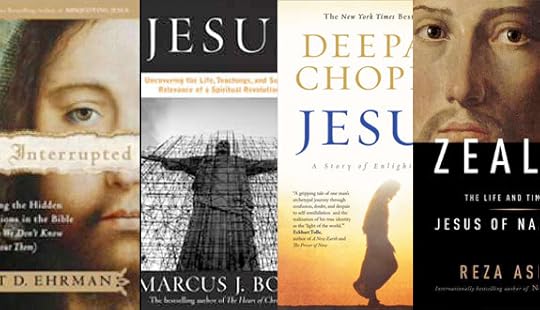
The
Messiah We Need, Not the Messiah We Want | Mark Shea | CWR
A
Jesus who constantly tells you that you are great and Those People
are the real trouble is a false one.
One
of the more confusing features of the gospels is the odd back and
forth relationship Jesus seems to have with the question of his
identity. It’s a matter confusing enough for the early Church that
seven ecumenical councils have to be held in order to iron the
question out and even today many people with only the dimmest
awareness of what the gospels say (due, among other things, to the
fact that 60%
of Americans can’t even name the four gospels)
have internalized the vague notion that Jesus was a nice guy who went
around saying wise things, doing kind stuff for poor people,
championing women’s rights, speaking truth to power about gays and
minorities and the Sacred Feminine, but who then ran afoul of The Man
and was executed for it, just like Martin Luther King, Jr. or Sophie
Scholl (if Americans knew who Sophie Scholl was).
If
his story had ended with him safely and securely dead (suppose an
increasing number of Westerners) things would have been great. He’d
be another do-gooder whose deathiversary might make for a national
holiday and a barbecue. Somebody we could reflect on before getting
back to Real Stuff (by which we mean money, sex, power, and honor).
But unfortunately (so the narrative goes) Jesus had the enormous bad
luck to have hand-picked the dumbest and cleverest band of
sociopathic hallucinators on the planet and they managed to both
totally misunderstand and pervert his simple message of love and
convince themselves he rose from the dead. Then, with even greater
improbability, they sold that yarn to lots of people two thousand
years stupider than us.
Then,
in an even worse stroke of bad fortune, a crazy epileptic rabbi named
Saul of Tarsus flipped out, became convinced the dead sage was not
only alive but was God, and single-handedly invented a religion about
Jesus. Shortly thereafter, (because three centuries passed a lot
more quickly in olden times than time passes today) Constantine made
that religion official and killed 50 bazillion herbal healer women as
witches and invented the papacy and banned sex and ordered the death
of Galileo and the destruction of the library at Alexandria and
issued rulers to nuns for rapping the knuckles of children in Garry
Wills’ third grade classroom.
August 13, 2013
Superior General of the Jesuits encourages youth to be “Ignatian people”
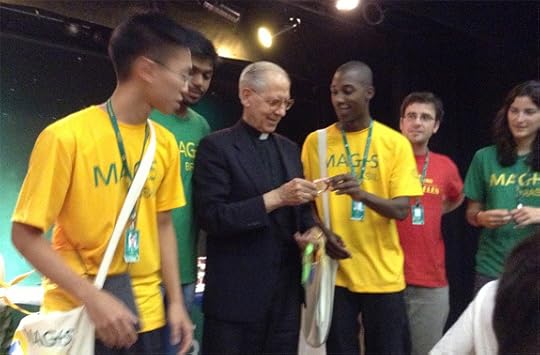
The author presents Fr. Nicolas with a gift at the MAGIS 2013 gathering in Sao Salvador, prior to WYD 2013.
Superior
General of the Jesuits encourages youth to be “Ignatian people” |
Allen
Ottaro | CWR blog
Fr.
Adolfo Nicolas, SJ, participates in the pre-WYD program, MAGIS Brasil
The
city of Sao Salvador da Bahia in North East Brazil, the first capital
of Brazil was the landing point for the first Jesuits in 1549, led by
Fr. Manuel da Nobrega.
In
July 2013, twelve days before the start of the World Youth Day week
in Rio de Janeiro, Sao Salvador da Bahia welcomed over two thousand
young people from fifty countries. The youth participated in the
Ignatian pre-WYD program, MAGIS
Brasil, which was prepared by the Brazilian Jesuits in
collaboration with other congregations of Ignatian charism and lay
collaborators.
Since
the late 1990s, Jesuits and other Ignatian religious have been
developing innovative programs which ran in parallel with the Papal
World Youth Days in various major cities, offering young people
spaces for prayer, service and companionship. Prior initiatives have
included Loyola XXI in Paris in 1997, Horizon 2000 in Rome in the
Jubilee Year, ANIA in 2002 at Toronto; and then MAGIS
in Köln in 2005, Sydney in 2008 and Madrid in 2011; all
participating alongside the official World Youth Day programs.
I
was blessed to be one of the over two thousand pilgrims, gathered at
the Jesuit high school, Colegio Antonio Vieira, first being a
three-day opening gathering in Sao Salvador, where all pilgrims were
received, welcomed and introduced to the program. The second part was
a one-week missionary experience divided into five categories:
Pilgrimage, Ecology, Spirituality, Art, Socio-Cultural Insertion and
Social initiatives. Each category had someone, Brazilians or
non-Brazilians as an inspiration, people who have testified their
life stories to life and evangelical service. For example, the
American missionary Sister Dorothy Stang was the inspiration for the
ecology experiences and is remembered for accompanying the life and
struggle of the field workers and indigenous communities in Brazil,
with determination and solidarity, especially in the Trans-Amazon
region. There were about 70 experiences all over Brazil, with twenty
to thirty young people from at least three nationalities, and a team
of people accompanying them.
The
third part of the program was the gathering in Rio de Janeiro, in
preparation for the start of the official World Youth Day week. The
gathering provided a wonderful opportunity for pilgrims to share
their experiences from the missionary week, and to get ready for the
main WYD events that included the official opening Mass and the
welcome ceremony for Pope Francis.
The
MAGIS 2013 opening gathering in Sao Salvador, was blessed
with the presence of Fr. Adolfo Nicolas, Superior General of the
Society of Jesus. Besides presiding over the opening Mass, Fr.
Nicolas also had the opportunity to meet with young representatives
of the fifty delegations.
Dietrich von Hildebrand on the Natural Ends of Religion
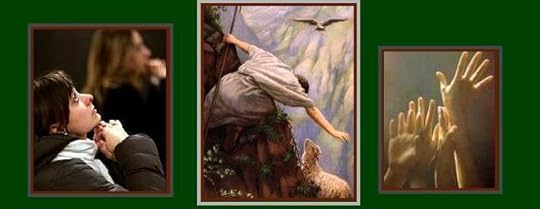
Dietrich von Hildebrand on the Natural Ends of Religion | Dr. Lance Byron Richey | Homiletic & Pastoral Review
The ultimate aim of all authentic religious practice, von Hildebrand always insists, is the creation of a truly supernatural life in the soul of the believer, in order to bring him to a final end with God that fallen nature can never hope to achieve with its own resources.
Few Christian philosophers of the 20th
century have had as keen an appreciation of the spiritual and religious
nature of the human person as did Dietrich von Hildebrand. One need
only recall the first lines of his classic Transformation in Christ to see the supreme importance of the supernatural destiny to which every man and woman is summoned:
God has called upon us to become new men in Christ. …
This new life … is not merely a moral perfection qualitatively identical
with natural morality, owing its supernatural meaning only to a
super-additive gift of grace; it is Christ’s supernatural wealth of
virtue, which in its very quality represents something new and distinct
from all merely natural virtue. 1
At the same time, von Hildebrand consistently and explicitly denied
that this religious destiny requires the destruction of our human
nature, or that our supernatural end should even be seen as in
fundamental tension with the ends to which we are directed by nature.
The venerable theological principle, “Grace builds on nature, it does
not replace it,” clearly governs his philosophy. However, while
everyone knows that von Hildebrand considered religion to be of supreme
importance in the supernatural life of man, little has been written
about his understanding of the role of religious belief and worship
(Christian or non-Christian) in ordering us towards our purely natural
ends, or to put it in his language, in enabling us to achieve at least
some of the purely natural “objective goods for the person.” To correct
this neglect, this paper will examine von Hildebrand’s understanding of
the “natural” ends of religion, and show how they contribute to the
supernatural goals of all true religion.
In order to better appreciate von Hildebrand’s understanding of the
“natural ends” of religious worship, I will first provide a brief
overview of his understanding of the distinction and relationship
between the natural and supernatural elements of the person. Next, I
will identify some of those “objective goods for the person” that are
proper to man as a natural being and, thus, do not require the gift of
grace for their accomplishment. Finally, I will explore how, for von
Hildebrand, religious belief and practice contributes to the
accomplishment of these natural ends. While enabling man to reach these
“natural” goods is obviously not the primary purpose of religion (which
is the transformation of the personality of the believer through
grace), it is, nevertheless, a real and important effect of religion
that can be defended on a purely philosophical basis.
The Cause for a Modern Prophet
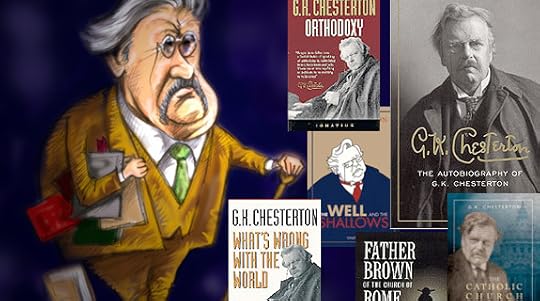
The
Cause for a Modern Prophet | Michael
Coren | CWR
Prolific and paradoxical, Gilbert
Keith Chesterton was as witty as Wilde, as original as Joyce, and as
clever as Kafka
When
even mass-circulation British newspapers cover a story about the
Church and beatification, you know it matters. The Daily Mail
recently
reported that, “Author G. K. Chesterton, best known for his
Father Brown stories, has been put on the path to sainthood – with
the blessing of the Pope. Just days before he was elected Pope in
March, the then Archbishop of Buenos Aires, Cardinal Jorge Bergoglio,
wrote to a Chesterton society in Argentina approving the wording of a
private prayer calling for his canonization.”
I wrote
a biography of Gilbert Keith Chesterton in 1988, and it was at a
conference about the man’s life and work in 1986 at the University
of Toronto that I met the woman whom I would marry, obliging me to
leave Britain and come to Canada. We also named our first child
Gilbert in honor of the man. (Our son’s middle name, though, as
romance must not lead to cruelty!)
Should
the great GKC be acknowledged as a saint? I'm not sure, really, but I
do know that we are generally not well served by journalism today.
Catholic journalists in particular sometimes seem more intent on
pleasing their secular friends than in defending the Church. Oh, for
another Chesterton, who wrote the truth of permanent things, of first
things, of Catholic things. His cause has been discussed and promoted
for some time, and in many ways it’s never been so fitting.
Born
in 1874 in London, England, he enjoyed the best in British private
education but chose not to go to university, which partly explains
his visceral refusal to adopt convention and think and write within
partisan definitions. He drifted into journalism but once afloat he
sailed perfectly, and often against the wind.
On
the fashionable nationalism of the Edwardian age, for example: “My
country, right or wrong, is a thing that no patriot would think of
saying except in a desperate case. It is like saying, my mother,
drunk or sober.” On literature: “A good novel tells us the truth
about it hero; but a bad novel tells us the truth about its author.”
On being controversial: “I believe in getting into hot water, it
keeps you clean.”
August 12, 2013
William P. Clark, 81, requiescat in pace
William P. Clark, close friend and aide to Ronald Reagan, died this past Saturday at 6:00 am, at his ranch in California. His biographer, Dr. Paul Kengor, stated, in an e-mail sent later that same day,
He died at the ranch so dear to his heart, surrounded by the family so dear to his heart.
Bill had been ailing for a long time—a long battle with Parkinson’s disease. He began receiving hospice care about six months ago. It’s amazing that he survived as long as he did. Typical of Bill, he kept hanging on and fighting and fighting. We expected him to go, but for some reason he still felt like he needed to stay in this world and do something more. He was always thinking of what he and Ronald Reagan called “The DP”—The Divine Plan.
Born October 23, 1931 in Oxnard, California, Bill Clark was 81 years old. He now joins his beloved wife, Joan.
The funeral Mass will take place this Wednesday, August 14, at 9:30 AM at Chapel Hill, the lovely church that Bill built himself on his ranch property outside of Paso Robles, California.
[F]ew individuals were as close and important to Ronald Reagan as Bill Clark. And beyond his impact on Reagan and the Cold War, Bill Clark was simply a wonderful man.
In 2007, Kengor, with co-author Patricia Clark Doerner, released the biography, The Judge: William P. Clark,
Ronald Reagan's Top Hand (Ignatius Press). In the Introduction, the authors wrote:
Clark has come full circle. He started life as a young man on a
California ranch, and now closes it as a man in his seventies on a
California
ranch, where he proudly struggles with the progression of
Parkinson's
disease. "God gave Parkinson's to such saints as John Paul II and my
father,"
he said, "and now he has gotten around to the sinners, such as
myself"
These sunset years are a time for reflecting on the past, as well as
for accepting what lies ahead. Though not without some regrets,
judge
Clark may be allowed a proper amount of satisfaction in his public
record. During the Sacramento years, Clark was appointed Governor
Reagan's chief of staff at a time of scandal and crisis and helped
to
right the ship
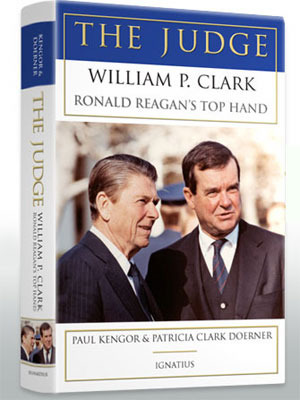 of state. When he thought his work done, he decided
of state. When he thought his work done, he decided
it
was time to return to his ranch. The Governor then named him superior
court judge, later elevated him to the court of appeal and, finally,
appointed him justice of the California Supreme Court. After Reagan
ascended to the presidency, he requested that Clark go with him to
Washington, where Clark became his deputy secretary of state, then
national security advisor and, lastly, secretary of the interior.
Official Reagan biographer Edmund Morris dubbed Clark the "most
impressive" advisor in the Reagan White House and "the most important
and influential person in the first administration". An August 1983
Time magazine cover story entitled "The Man with the
President's
Ear", informed the public that next to Reagan, Clark was the "most
powerful man in the White House", so close to Reagan, and so loyal
to and trusted by the President, that White House staff called him
Uncle Bill.
"He was always there when my Dad needed him", says the former
President's oldest son, Michael. "He was very important to my dad's
career.
And their relationship was more than political; they were good friends."
President Reagan himself told the press that Clark was "one of my
most trusted and valued advisers." Again, "no one has given me more
faithful service above and beyond the call of duty." [5] When Reagan had
a tough task, he called upon Clark, his troubleshooter, his
right-hand
man. [6] As photographs illustrate, Bill Clark was often literally at
Reagan's
right side, and always trying to fulfill the adage that he coined, "Let
Reagan
be Reagan." No one was more inclined to let Reagan act on his
instincts.
Nowhere was this more true than in determining policy in regard
to the Soviet Union. During two critical years as Reagan's national
security advisor, Clark helped lay the groundwork for the
administration's remarkable effort to undermine Soviet communism and win
the
Cold War. Another cover story at the time, in the New York Times
Magazine, noted that Clark was not only "the most influential
foreign-policy figure in the Reagan administration", but also "the
president's
chief instrument" in confronting Soviet influence in the world. The
two of them, often alone, met to discuss some of the boldest and
most
successful actions of the entire Cold War. As the New York Times'
White House correspondent reported, colleagues observed Clark returning
from his private meetings with Reagan and prepared themselves
for the "important decisions" to come.
In a 2007 interview with Ignatius Insight, Kengor highlighted Clark's humility, faith, and loyalty:
Ignatius Insight: Who is
William P. Clark and why did you co-author a book about his life?
Paul Kengor: William P. "Bill" Clark, who is known as "The Judge"
because of his years of service in the California court system, including the
California Supreme Court, is a terrific story that is required reading for
every Catholic, not to mention non-Catholics as well, of course. Catholics
especially, however, need to know that this man, in my opinion, was the single
most important Catholic in the fall of the Soviet Union, next to only Pope John
Paul II. That's quite a statement, but it is easy to defend.
Readers will need to read the
book to learn why, but I will give one example of his enormous impact on the
end of the Cold War: Ronald Reagan, as we now know, had a deliberate policy to
undermine atheistic Soviet communism and win the Cold War. That policy was laid
out in several crucial NSDDs—National Security Decision
Directives—that have since been declassified by the federal government
and are now available at the Reagan Library. These NSDDs reveal an unmistakable
attempt to undermine and change the Soviet system. I will quote just two of
them.
Here's NSDD-32, which
described this Reagan administration objective toward the USSR: "To contain and
reverse the expansion of Soviet control and military presence throughout the
world.... [T]o contain and reverse the expansion of Soviet influence worldwide."
Another was NSDD-75, which
stated this similar intention: "To contain and over time reverse Soviet
expansionism.... This will remain the primary focus of U.S. policy toward the
USSR. To promote ... the process of change in the Soviet Union toward a more
pluralistic political and economic system in which the power of the privileged
ruling elite is gradually reduced."
These were grand objectives
that the establishment and the experts judged utterly impossible, and yet
precisely that occurred before the decade ended.
As I learned when I first
read these extraordinary documents at the Reagan Library—smoking-gun
evidence, a paper trail showing that this was the actual Reagan administration
objective—I was stunned to learn that they were all done in the brief
two-year window that Bill Clark served as Reagan's national security adviser.
Clark oversaw the development of these NSDDs. In fact, he oversaw the
development of over 100 of these NSDDs. Clark was the guy at the head of the
Reagan railroad who laid the track to Cold War victory, and then silently rode
of into the sunset and didn't talk about what he did—a humility derived
from his upbringing and strong Catholic faith.
The book is filled with
policy specifics that flowed from that objective, from Clark shepherding
everything from Reagan's Strategic Defense Initiative (SDI) to the president's
covert plan to bankrupt the USSR through economic warfare.
IgnatiusInsight.com: What
were Clark's top accomplishments during his time in Washington, DC in the
1980s?
Paul Kengor: Winning the Cold War. Beyond that, he was always
there for Ronald Reagan as the president's sure-thing, as his most trusted,
dependable adviser—as his constant troubleshooter always ready for
deployment on the most sensitive mission. Reagan could count on Clark do always
do his job and to complete the most sensitive mission in complete confidence,
without blabbing about it. In the book, we disclose for the first time the
extraordinary April 1983 covert mission to save the South American country of
Suriname from becoming a Soviet-Cuban proxy state. Clark and crew kept this
quiet for over twenty years, talking only now. Historians need to learn about
this. This is for the history books. We lay out all the details in the book.
IgnatiusInsight.com: What
were some of the challenges involved in writing this biography?
Paul Kengor: My biggest challenge was getting this humble man to
tell this significant story, which is also simply a good story about a man and
his spiritual journey, aside from the historical significance of what he and
Reagan did together. I knew this was a wonderful story in all aspects. I
finally prevailed—with the indispensable help of Pat Clark Doerner, a
God-send on this project—only by consistently appealing to Bill Clark's
sense of duty, duty to the Reagan record and legacy and duty to history.
Cognitive Dissonance on the Issue of Marriage and Procreation

Cognitive Dissonance on the Issue of
Marriage and Procreation | Bill Maguire | CWR blog
Can you correctly identify who made the
following comments on the importance of fathers for the well-being of
children and the health of our communities?
When
fathers are absent . . . we know the damage that does to our
families. Children who grow up without a father are more likely to
drop out of school and wind up in prison. They’re more likely to
have substance abuse problems, run away from home, and become teenage
parents themselves.
There's
no more important ingredient for success—nothing would be more
important for us reducing violence—than strong, stable families,
which means we should do more to promote marriage and encourage
fatherhood.
A
father's absence is felt by children, families, and communities in
countless ways, leaving a hole that can have lasting effects.
If you guessed
these comments were made by a
right-winger or by a pastor, preacher, or priest—you are incorrect.
These were, in fact, words spoken by President Obama. If you want to
read more about how essential involved fathers are for the health and
well-being of our children and communities, visit
the website for the President’s Fatherhood Pledge.
Those of us in
the movement to promote marriage and safeguard it from being
redefined welcome President Obama’s statements. He rightly
understands both the unique and necessary contribution of fathers and
the explicit link between fatherhood, the well-being of children, and
the health of our communities. Yet, in light of his current policies,
we are left scratching our heads.
The Question for Our Age: “Quo Vadis?”
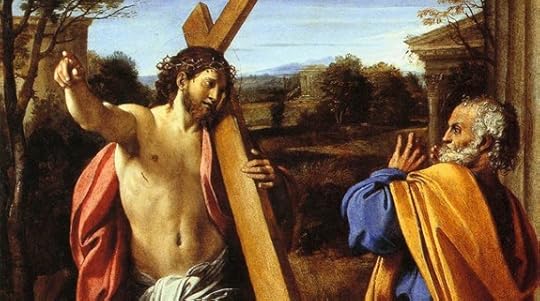
The Question for Our Age: “Quo Vadis?” | James Kalb | Catholic World Report
Where will the present situation lead if our secular authorities continue on their present course?
Secular liberalism is at odds
with Catholicism. The point seemed obvious to most people until the postwar
period, when the thought took hold that an essentially harmonious relationship
could be established that would draw on the American model. America, it seemed,
was different from Europe with its long tradition of statism and
anti-clericalism. It rejected an established church, but embraced religious
freedom, an active and diverse civil society, and a limited and decentralized
government that did not try to dominate culture and gave the Church the
protection and freedom she needed to thrive.
The attempt to establish a
harmonious relation with the liberal state has been less fruitful than hoped,
and even in America has run into profound difficulties. Our government and
other authoritative institutions have become more centralized and more
concerned with remodeling all aspects of life, including the beliefs and
attitudes of the people. We are becoming more like Europe, and to make matters
worse the outlook of the governing classes on both sides of the Atlantic has
moved in a direction radically opposed to both religion and natural law.
Throughout the Western world, Catholics and Catholic institutions are
increasingly required to conform to anti-Catholic norms, and in much of it you
can be punished as a criminal for public assertion of Catholic moral doctrine.
The intolerance is aimed less at
Catholicism in particular, although the Church is a highly-visible target, than
any form of Christianity that does not reduce without remainder to progressive
politics and private therapy. We are increasingly ruled by practical utopians
who believe themselves comprehensively responsible for human relations, and
their efforts leave no place for an independent and refractory organization
like the Church that proposes a contrary vision that now counts as
intrinsically antisocial and oppressive.
So where will the present
situation lead if—as seems quite possible—our secular authorities continue on
their present course? Will the blood of the martyrs once again be the seed of
the Church, or will multiplying restrictions and disabilities wear down
Catholic life until the Church all but disappears?
August 10, 2013
The Vigilant and Faithful Disciple
Readings:
• Wis 18:6-9
• Ps 33:1, 12, 18-19, 20-22
• Heb 11:1-2, 8-19
• Lk 12:32-48
“What is the mark of a Christian?”
asked St. Basil in his work, Moralia, which is a guide living
a morally upright life in the world. How might we answer this
question? To be kind. To be charitable. To give to the poor.
These are all good answers, but St. Basil’s answer emphasized
something else: “It is to watch daily and hourly and to stand
prepared in that state of total responsiveness pleasing to God,
knowing that the Lord will come at an hour that he does not expect.”
A true Christian is vigilant, meaning he is ready to hear God’s
word and to respond accordingly.
Today’s readings are about vigilance,
especially as they relate to the virtues of faith and hope. In fact,
vigilance is really impossible with faith and hope, for the disciple
of Christ stands prepared because he believes in faith that the Lord
has come and will come, and because he believes in hope that Christ
will fulfill the promises granted through the new covenant, the
Church, and the sacraments.
The Book of Wisdom was written by a
well-educated, anonymous Jewish author living around Alexandria,
Egypt, between 180 and 50 B.C. The “night of the Passover” was,
of course, a definitive moment for the Israelites. “It was a night
of watching by the LORD, to bring them out of the land of Egypt”
(Ex. 12:42). The vigilance kept on the night of Passover was based on
the promise and the “knowledge of the oaths in which they put their
faith,” which had been given to them by God through Moses.
This vigilance was not just a matter of
waiting and watching, however, for it also involved the sacrifice of
an unblemished lamb. The blood of the lamb was to be put on the
doorposts as a sign of their faith, and then the lamb was to be eaten
(Ex. 12:3-14). This led, then, to two essential acts: the liberation
of the people and the destruction of their enemies.
Hebrews 11 is a powerful, even poetic,
celebration of vigilant, active faith. It opens by stating that faith
“is the realization of what is hoped for and evidence of things no
seen.” Faith is rooted in God’s actions and words in the past and
looks with hope toward the future and “a better homeland, a
heavenly one” (Heb. 11:16). Abraham, filled with faith, obeyed when
he was called to go to the promised land. Vigilant, he responded,
even though he was not certain of where God was leading him, but
believing that God had a prepared a city for him.
That city is heaven, the new Jerusalem,
the dwelling place of God. There is but one holy land, and it was
inaugurated by Jesus Christ, who is the new Moses, “the pioneer and
perfecter of our faith” (Heb. 12:2). He inaugurated the kingdom
through preaching and teaching, and by establishing the Church, the
“little flock” referred to in today’s Gospel. “The Word of
the Lord,” states Lumen Gentium, “is compared to a seed
which is sown in a field; those who hear the Word with faith and
become part of the little flock of Christ, have received the Kingdom
itself” (par. 5).
Again, vigilance and obedience are
essential; those who listen with anticipation and respond in faith
will receive the Kingdom. Jesus’ exhortation to alert faith is
meant for all Christians, but he explained to Peter that his words
held a special gravity for the apostles and their successors. The
master, Jesus, has given his servants, the apostles, unique authority
in the household of God. The slothful or ignorant servant will suffer
severely. “Much will be required of the person entrusted with much,
and still more will be demanded of the person entrusted with more.”
Our prayer should echo that uttered by
Blessed Elizabeth of the Trinity, that we will be “completely
vigilant in my faith, entirely adoring, and wholly given over to your
creative action” (CCC 260).
(This "Opening the Word" column originally appeared in the August 8, 2010, issue of Our Sunday Visitor newspaper.)
August 9, 2013
Auschwitz and Catholic Jews

Auschwitz and Catholic Jews | Dr. Ralph McInerny | Foreword to Edith Stein and Companions, On the Way to Auschwitz, by Father Paul Hamans | Ignatius Insight
Once, in monasteries, religious houses, and seminaries, the Roman Martyrology was read in the refectory before meals. Each day some of those who had given their lives in witness to the faith were commemorated by name, and
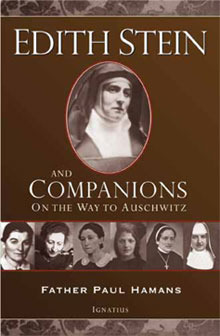 often the tortures they underwent were described. Each day's entry ended with a sentence beginning "et alibi aliorum plurimorum sanctorum.... " And elsewhere many other saints. ... This tradition continues in some monasteries.
often the tortures they underwent were described. Each day's entry ended with a sentence beginning "et alibi aliorum plurimorum sanctorum.... " And elsewhere many other saints. ... This tradition continues in some monasteries.We may feel sad for all the anonymous martyrs gathered into that commodious final sentence, but that would be a mistake. They are all entered in the Book of Life, and the names of each are known to God. For all that, it is important for us, not for them, that the names and sufferings of some be explicitly known by us. The saints are put before us as models of the Christian life, and martyrs are the ultimate models. We need to know more about some of them.
In this remarkable book, Dr. Paul Hamans, Father Hamans, has undertaken the onerous task of compiling biographies, often accompanied by photographs, of many of the religious and laity who were rounded up from their various convents and monasteries and homes on the same day as Saint Edith Stein, August 2, 1942; most of them were taken to the Amersfoort concentration camp and from there put on trains to Auschwitz, where the majority, soon after their arrival at the camp, were gassed and buried in a common grave between August 9 and September 30, 1942. They were all Catholic Jews, and their arrest was in retaliation for the letter of the Catholic bishops of the Netherlands that was read from the pulpits of all churches on July 26, 1942.
Over the past few years, in striking contrast to contemporary acknowledgments and the magnificent book of Jewish theologian and historian Pinchas Lapide, many authors have accused the Church of silence during the Nazi persecution of the Jews. None of the counterevidence to this shameful thesis has had any effect on the critics. The experience of Jews in the Netherlands, particularly Catholic Jews, is eloquent witness of what could result from public condemnation of the Nazis. The victims whose stories are included in this book were told that they were rounded up in direct retaliation of the condemnation of the Nazi "final solution" by the Dutch bishops.
Elsewhere, as was once acknowledged and celebrated, the Church in many ways, and in many countries, provided the principal help to European Jews. Indeed, the Catholic Church, under the leadership of Pope Pius XII, is credited by Lapide with saving the lives of some 860,000 Jews. These efforts were effective largely because they were not accompanied by noisy public declarations. With the appearance of the mendacious play of Rolf Hochhuth,The Deputy, in 1963, the tide turned, and a series of progressively more intemperate accusations against the Church and Pius XII began to appear. Some Jews reacted to mention of the non-Jewish victims of the Nazi persecution as if it were in some way an effort to diminish the tragedy that had befallen the Jewish people under the reign of Hitler. There were even objections from some Catholics when Edith Stein was canonized and characterized as a martyr. Their argument was that she was put to death as a Jew, not as a Catholic. And some sad souls objected to acknowledgment of what had happened to Catholic Jews like Edith Stein and her companions. This book is an indirect reply to such criticisms and will speak to all who have ears with which to hear.



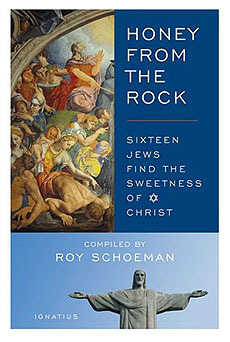


That the ultimate sacrifice of the Catholic Jews arrested in the wake of the Dutch bishops' protest should become a cause of controversy is a sad indictment of these last days. But it cannot touch the nobility and holy resignation with which they met their end. Pondering the people commemorated in this book should be an occasion, not for argument, but for edification. Father Hamans has put us in his debt for having taken on the enormous task of making them flesh-and-blood persons for his readers. During the ordeal, one nun wrote to her superior that they had all become numbers to their captors. Lists had been drawn up with diabolical bureaucratic efficiency by the Nazis, which is why the arrests were made so promptly.
Thanks to this book, they are no longer mere numbers. Like those mentioned in the Martyrology, their names have been restored. But, again, the importance of that is largely for us. They would have been content, like perhaps millions of others, with the collective mention of the army of martyrs in the Te Deum Laudamus:
Te martyrum candidatus laudat exercitus.
Ralph McInerny
University of Notre Dame
September 2010
 Edith Stein and Companions On the Way to Auschwitz
Edith Stein and Companions On the Way to Auschwitzby Father Paul Hamans
• Also available as an E-Book
On the same summer day in 1942, Saint Teresa Benedicta of the Cross (Edith Stein) and hundreds of other Catholic Jews were arrested in Holland by the occupying Nazis. One hundred thirteen of those taken into custody, several of them priests and nuns, perished at Auschwitz and other concentration camps. They were murdered in retaliation for the anti-Nazi pastoral letter written by the Dutch Catholic bishops.
While Saint Teresa Benedicta is the most famous member of this group, having been canonized by Pope John Paul II in 1998, all of them deserve the title of martyr, for they were killed not only because they were Jews but also because of the faith of the Church, which had compelled the Dutch bishops to protest the Nazi regime. Through extensive research in both original and secondary sources, P.W.F.M. Hamans has compiled these martyrs' biographies, several of them detailed and accompanied by photographs. Included in this volume are some remarkable conversion stories, including that of Edith Stein, the German philosopher who had entered the Church in 1922 and later became a Carmelite nun, taking the name Sister Teresa Benedicta of the Cross.
Several of the witnesses chronicled here had already suffered for their faith in Christ before falling victim to Hitler's "Final Solution", enduring both rejection by their own people, including family members, and persecution by the so-called Christian society in which they lived. Among these were those who, also like Sister Teresa Benedicta, perceived the cross they were being asked to bear and accepted it willingly for the salvation of the world. Illustrated
"Father Hamans has put us in his debt for having taken on the enormous task of making the Jewish Catholic martyrs flesh and blood persons."
--Ralph McInerny, from the Foreword
"An important, beautiful, heart-wrenching book. These Jewish Catholics, were doubly blessed, for they were martyred twice--once, when they entered the Catholic Church at the cost of losing their families, their homes, their livelihoods, and a second time when they were sent to the extermination camp as Jewish Catholics. Martyred for their Catholic faith, martyred for their Jewish blood. The faith, dedication to God, and love of the Church that they showed as they underwent this double martyrdom are inspiring reminders of what the true stakes and rewards of our lives as Catholics are."
--Roy Schoeman, Author, Salvation is From the Jews
Fr. Paul Hamans is a diocesan priest in Roermond, Netherlands, where he teaches Church history at the seminary there. He has a doctorate in history from the University of Augsburg, Germany, and is an expert on the Dutch martyrs of the twentieth century. His other publications include History of the Catholic Church in the Netherlands.
Related Ignatius Insight Excerpts and Essays:
• The Cross and The Holocaust | Regis Martin
• Chapter 1 of Priestblock 25487: A Memoir of Dachau | Fr. Jean Bernard
• The Jews and the Second Coming | Roy H. Schoeman
• Judaism Fulfilled | An interview with Roy H. Schoeman
• Jews Find the Sweetness of Christ | Roy Schoeman
Dr. Ralph McInerny (1929-2010), was a longtime professor of philosophy and director of the Jacques Maritain Center at Notre Dame. He began teaching at the University of Notre Dame in 1955; he was the author of two dozen scholarly books and many more scholarly essays, as well as numerous general interest works. He was an expert in the work of Thomas Aquinas, Soren Kierkegaard, and Jacques Maritain, and wrote and lectured extensively on ethics, philosophy of religion, and medieval philosophy. He also wrote over fifty novels, including the well-known Father Dowling mystery series and The Red Hat .
Carl E. Olson's Blog
- Carl E. Olson's profile
- 20 followers



